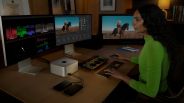For four decades, the Heimlich maneuver has been saving the lives of choking victims all over the world, and has become both a household word and a standard first-aid technique.
Its inventor, thoracic surgeon Dr. Henry Heimlich, has now written a memoir that chronicles his research and development, and eventual perfection of the maneuver.
The memoir is called "Heimlich's Maneuvers: My Seventy Years of Lifesaving Innovation," and focuses on the maneuver, how it is done correctly, and the various situations in which it can be used to relieve a person from choking, if not to save a life.
In 1972, Dr. Heimlich read an article in the Sunday New York Times Magazine about accidental deaths, and choking was number 6 on the list. The article said that in 1972 in the United States, three thousand people died from choking, often from the most ordinary things and during ordinary moments, such as on a piece of food while having supper. That started him thinking that the first-aid maneuvers that were being used to stop choking at the time may not be very effective.
Choking was so rampant that the term "Café Coronary" was coined to refer to a situation in which a person in a restaurant chokes to death, while the people around him stand around and think he is having a heart attack.
Other incidents of choking not being properly handled are even more shocking. Dr. Heimlich recalled an incident in which a physician tried to perform a tracheotomy on his choking wife. "He literally slit her throat, cutting her carotid artery in the process, and she died of a hemorrhage. Yet, one of the recommendations, before the Heimlich maneuver came along, for saving choking victims was to slit open the trachea in the neck with a knife," said Dr. Heimlich.
In 1973, Dr. Heimlich began researching the problem of choking in his laboratory at the Jewish Hospital in Cincinnati using a variety of contraptions that included tubes, balloons, and small objects that may pose choking hazards. Eventually it was his experiment with four anesthetized beagles that led him to the Heimlich maneuver as we all know it now.
In 1974 he shared his maneuver with the world. He wrote an article detailing the instructions for the maneuver, which was published by Emergency Medicine in its June 1974 issue. He also appeared as guest on radio and television shows such as "Good Morning America" and "The Tonight Show with Johnny Carson." It was in the August 12, 1974 issue of JAMA that the maneuver got a name: the Heimlich maneuver. Shortly after that, the Heimlich maneuver was endorsed by the American Medical Association Commission on Emergency Medical Services.
Dr. Heimlich said that at the time, he didn't know that his method will save a choking person, "but the alternative is to let a choking person die. We did not have to wait long for results."
For decades now people have been writing to Dr. Heimlich, now 94, letters of thanks for his maneuver, telling him of situations in which they were able to save loved ones and even complete strangers from dying because of choking.
The main appeal of the Heimlich maneuver is that it is not a professional procedure. Anyone can do it, even Clint Eastwood, who was at a gold tournament in Monterey when he saw the tournament director choking on a piece of cheese. He quickly went over, performed the Heimlich maneuver, and relieved the victim of the cheese that was clogging his windpipe. That must have made the tournament director's day, as well as Eastwood's and Dr. Heimlich's.
ⓒ 2025 TECHTIMES.com All rights reserved. Do not reproduce without permission.




